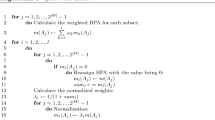Abstract
With the increment of focal elements number in discernment framework, the computation amount in Dezert-Smarandache Theory (DSmT) will exponentially go up. This has been the bottleneck problem to block the wide application and development of DSmT. Aiming at this difficulty, in this paper, a kind of fast approximate reasoning method in hierarchical DSmT is proposed. Presently, this method is only fit for the case that there are only singletons with assignment in hyper-power set. These singletons in hyper-power set are forced to group through bintree or tri-tree technologies. At the same time, the assignments of singletons in those different groups corresponding to each source are added up respectively, in order to realize the mapping from the refined hyper-power set to the coarsened one. And then, two sources with the coarsened hyper-power set are combined together according to classical DSm Combination rule (DSmC) and Proportional Conflict Redistribution rule No. 5 (PCR5). The fused results in coarsened framework will be saved as the connecting weights between father and children nodes. And then, all assignments of singletons in different groups will be normalized respectively. Tree depth is set, in order to decide the iterative times in hierarchical system. Finally, by comparing new method with old one from different views, the superiority of new one over old one is testified well.
Similar content being viewed by others
References
F. Smarandache and J. Dezert (Editors). Advances and applications of DSmT for information fusion. American Research Press, Rehoboth, USA, Vol. 1, Vol. 2, and Vol. 3, 2004/2006/2009.
J. Gordon and E. H. Shortliffe. A method for managing evidential reasoning in a hierarchical hypothesis space. Artificial Intelligence, 26(1985)3, 323–357.
G. Shafer and R. Logan. Implementing Dempster’s rule for hierarchical evidence. Artificial Intelligence, 33(1987)3, 271–298.
G. Shafer, P. P. Shenoy, and K. Mellouli. Propagating belief functions in qualitative Markov trees. International Journal of Approximate Reasoning, 1(1987)4, 349–400.
U. Bergsten and J. Schubert. Dempster’s rule for evidence ordered in a complete directed acyclic Graph. International Journal of Approximate Reasoning, 9(1993), 37–73.
B. Tessem. Approximations for efficient computation in the theory of evidence. Artificial Intelligence, 61 (1993), 315–329.
T. Denoeux and A. B. Yaghlane. Approximating the combination of belief functions using the fast möbius transform in a coarsened frame. International Journal of Approximate reasoning, 31(2002), 77–101.
A. L. Jousselme. A new distance between two bodies of evidence. Information Fusion, 2(2001), 91–101.
Author information
Authors and Affiliations
Corresponding author
Additional information
Supported by the National Natural Science Foundation of China (No. 60804063).
Communication author: Li Xinde, born in 1975, male, Ph.D..
About this article
Cite this article
Li, X., Wu, X., Sun, J. et al. An approximate reasoning method in Dezert-Smarandache Theory. J. Electron.(China) 26, 738–745 (2009). https://doi.org/10.1007/s11767-009-0084-5
Received:
Revised:
Published:
Issue Date:
DOI: https://doi.org/10.1007/s11767-009-0084-5




